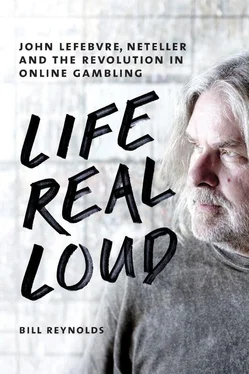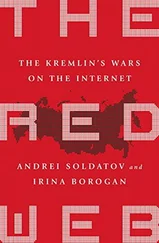The free ride was over for Neteller — no more discounts. On top of that, PayPal had also discovered the obvious. Since Neteller was a customer, PayPal already had a built-in online gambling client base. “Yeah,” Lefebvre says, “it took them a long time to figure that out.”
PayPal gave Neteller three choices. Option one: PayPal does the accumulating exclusively in its partnership with Neteller. Option two: PayPal does some of the acquiring, but not exclusively, and for that right PayPal charges Neteller a preferred rate, like two percent. And option three: PayPal and Neteller aren’t partners, and Neteller gets dinged 3.25 percent, the top rate, for using PayPal’s system. “In other words, Lefebvre said, “the third alternative is you can tell us to go fuck ourselves and we can go toe to toe with you.”
For months PayPal had let Neteller make an excellent return right under its nose. That was no longer on. PayPal also caught on to something even more tantalizing: the glory of the “churn.” By making terms as attractive as possible for bookies, Neteller found it could keep a customer’s money in the system, betting over and over and over. PayPal finally understood that over half of every dollar in a Neteller account would eventually go to Neteller. Eyes opened wide, PayPal executives wanted in on that action.
There wasn’t much Lefebvre and Lawrence could do. Their initial reaction was, “Geez, don’t be so hasty,” but their gambit was over. Compared to PayPal their company was puny, about as puny as their market share would be once PayPal, one of the burgeoning internet age’s few instantly recognizable brand names, moved into its territory. It might even be game over for Lawrence and Lefebvre’s brilliant business plan. Neteller was now vulnerable, like a snail flushed out onto the sidewalk after a rainstorm. PayPal could scuff it into the ground. Maybe it ought to cooperate. Lefebvre recalls, “We said, ‘Well, listen, this is all very interesting. We’re honored that you’d consider doing business with us. We’re going to go and sharpen up our pencils and see where we feel we should be landing with you.’”
And then the two Neteller cofounders left PayPal headquarters and grabbed a cab. About five minutes into the twenty-mile ride from Palo Alto to San Francisco International, they started talking about the deal on the table. Lefebvre recounts the conversation:
“What do you think?” asked Lefebvre.
“I don’t think we need those guys,” replied Lawrence.
“Really, do you think we can get credit card transfers?”
“Yeah, and we’re getting really close on EFT, too, so …”
“You know what, if we work with them as partners they’re going to control us and try to tell us what we can do, what we can’t do. It’s us completely giving up our autonomy. Why wouldn’t they just use us to learn the system and then just kick us the fuck out and take over? They’ve got all the same infrastructure we’ve got. We would be lambs to the slaughter if we did any business with these guys — they’re setting us up!”
Lawrence didn’t interrupt Lefebvre’s rant.
“We’re getting really close to football season,” he continued, “so if we’re gonna dump ’em, let’s dump ’em right now so we can get used to running without them. Once football season starts we’ll be used to running without ’em.”
“Yup,” said Neteller’s CEO, “that’s what we should do.”
Lefebvre concludes, “So we phone Calgary and Steve says to Glav, ‘Take PayPal off our site. Send out messages to all your PayPal guys, tell them to get their money into Neteller because we’re taking PayPal off our site by tomorrow.’”
Glavine started to freak. What about the numbers? Guys, they don’t lie. Glavine knew how much of Neteller’s business went through PayPal — ninety-five percent. It sounded like financial hara-kiri to him. Glavine recalls the scary moment:
Like, we’d just gotten our own ACH working. After PayPal’s initial three-day shutdown I spent a week searching to see if we could do it ourselves. I didn’t want to be beholden to these guys. I found a guy in California who said he would do it. After three or four months of programming and setting up the system, we started our own ACH. It was working, but it was slow. It was maybe two or three percent of our business at the time.
And so Steve is saying, “We’ve got to shut PayPal down.” I’m like, “Steve, I don’t think this is the time to do it.” All Steve says is “Is our ACH working?” I say, “Yeah, it’s working pretty good.” And he says, “Then turn it off.”
I go on the website and block out the PayPal deposit option, upload the page, and that was the end of PayPal. Our deposits dropped ninety percent instantly.
It was a gutsy call, but Lawrence was right. A bunch of customers did as they were told and sent money. Neteller disconnected PayPal, and the company was on its own.
“The next morning PayPal phones,” says Lefebvre. “They say, ‘What are you doing?’ And we say, ‘Well, we’ve made our election. Good luck to you.”
Glavine was impressed by Lawrence’s acumen: “Within three weeks or so we were right back where we were.”
PayPal’s response was swift, aggressively moving into Neteller’s market. It recruited and sent out dozens of sales personnel to travel the globe and wine and dine both current and potential B2B customers. They campaigned hard and scooped up business. They had direct contact with all the merchants and had huge market penetration, around fourteen million members. Neteller had around two hundred thousand members, 1.4 percent of PayPal’s. Neteller estimated that PayPal was getting ten times the business, but the smaller company still had one aspect in its favor: Because of the months of free funding courtesy of PayPal, Neteller had cash flow. “By then,” says Lefebvre, “we had something like a million a month running through the system.”
Despite being a small company, now without the protective PayPal exoskeleton, the Neteller business model held. The customer base did not shrink; in fact, it grew at much the same rate as before, this time not at the mercy of another company. Lawrence had vaporized PayPal’s ability to pull the plug on Neteller’s transactions on a whim.
But the rivalry was worrisome. Neteller had gotten into the game early, which was good. It had solved its money transfer bottleneck before expiring, which was good (and perhaps lucky). But now it was going to get royally clocked by this formidable brand name, which wasn’t good at all. Just stomped on over and over. And yet the strange thing was, yeah, sure, PayPal might have been way, way, way bigger than Neteller ever would be — the ape and the ant — but at this point it was beginning to dawn on Lawrence, Lefebvre, et al. that, like, who cares? The industry was growing like an out-of-control California bushfire.
So that’s the way it went from August 2000 into April 2001, from investor’s cash to near-death to stealth success to getting caught out to going it alone. Lefebvre would soon be leaving the Keg office to set up a satellite in San José, Costa Rica, and talk up bookies and build market share. Lawrence would lease back to Neteller some of his own office space, one of the bays of the Midnapore property he owned way down in the south end. A flooring company had moved out, freeing up retail space. In summer 2001, the company pulled a midnight move out of the Keg building. This period marked another change for the company, says Lefebvre. “It was during the Midnapore era that we began to explore going public.”
It was also during this period, when the money began to roll in, that the two cofounders decided to increase their salaries, by two and a half times, to $5,000 per month. It still wasn’t much, but to Lefebvre, a guy in his late forties who only a couple of years earlier had been bumming around playing music at CTrain stops, an annual salary of sixty grand — and no law practice — was nirvana.
Читать дальше












